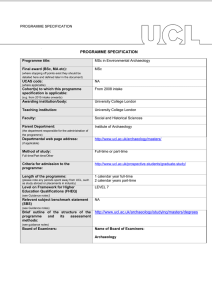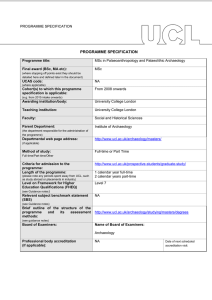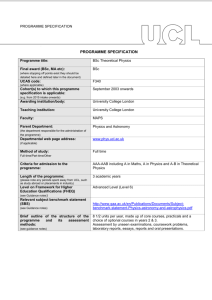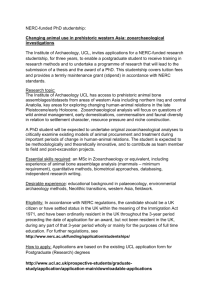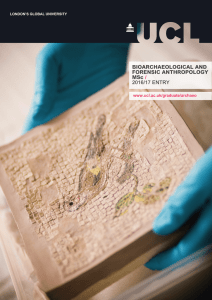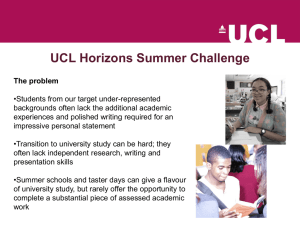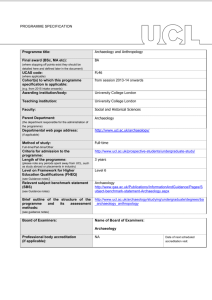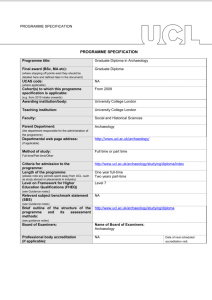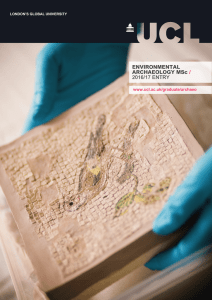MSc Bioarchaeological and Forensic
advertisement
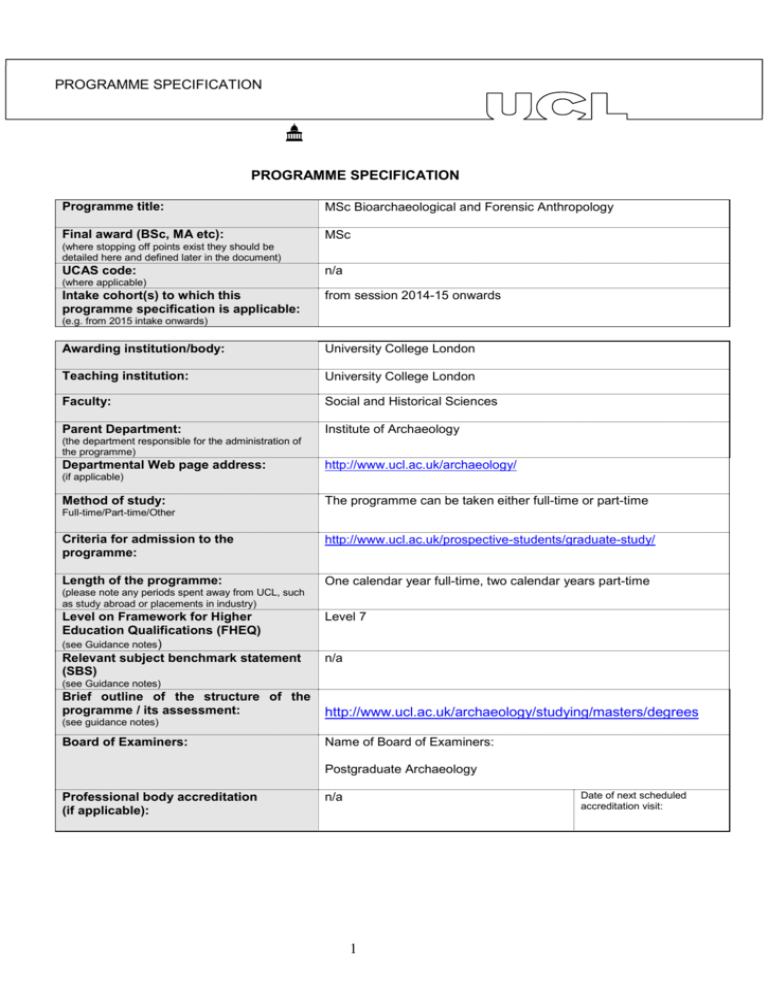
PROGRAMME SPECIFICATION PROGRAMME SPECIFICATION Programme title: MSc Bioarchaeological and Forensic Anthropology Final award (BSc, MA etc): MSc (where stopping off points exist they should be detailed here and defined later in the document) UCAS code: n/a (where applicable) Intake cohort(s) to which this programme specification is applicable: from session 2014-15 onwards (e.g. from 2015 intake onwards) Awarding institution/body: University College London Teaching institution: University College London Faculty: Social and Historical Sciences Parent Department: Institute of Archaeology (the department responsible for the administration of the programme) Departmental Web page address: http://www.ucl.ac.uk/archaeology/ (if applicable) Method of study: The programme can be taken either full-time or part-time Full-time/Part-time/Other Criteria for admission to the programme: http://www.ucl.ac.uk/prospective-students/graduate-study/ Length of the programme: One calendar year full-time, two calendar years part-time (please note any periods spent away from UCL, such as study abroad or placements in industry) Level on Framework for Higher Education Qualifications (FHEQ) (see Guidance notes) Relevant subject benchmark statement (SBS) Level 7 n/a (see Guidance notes) Brief outline of the structure of the programme / its assessment: (see guidance notes) Board of Examiners: http://www.ucl.ac.uk/archaeology/studying/masters/degrees Name of Board of Examiners: Postgraduate Archaeology Professional body accreditation (if applicable): Date of next scheduled accreditation visit: n/a 1 EDUCATIONAL AIMS OF THE PROGRAMME: To develop students’ interest in, knowledge and understanding of the study of skeletal and dental remains in archaeology, the evolution and origins of modern humans, demography, development of disease, and the application of forensic anthropological methods and techniques to modern and ancient material. PROGRAMME OUTCOMES: The programme provides opportunities for students to develop and demonstrate knowledge and understanding, qualities, skills and other attributes in the following areas: A: Knowledge and understanding A Knowledge and understanding of: 1. Basic skeletal and dental anatomy 2. Variation in skeletal and dental form within populations, between males and females, between populations 3. Evolution of modern humans 4. Development of bones and teeth in relation to diet and health 5. Estimation of age at death from bone and tooth development, and the study of palaeodemography 6. Identification of diseases and injuries in the skeleton and dentition, and the study of palaeoepidemiology 7. The position of 2-6 above in the wider context of archaeology 8. Key methods for the analysis of skeletal and dental remains, and for the organisation of a research project in this field 9. Learn and apply forensic anthropological techniques to modern and archaeological skeletal material Teaching/learning methods and strategies: Acquisition of 1, together with elements of 2, 4, 5, 6, 8 & 9 is through weekly practical classes and work with the teaching collection in the students’ own time (in booked sessions). Lectures and seminars, with conversations during practicals, are designed to develop 2-9. The report written in the “Methodology and issues in bioarchaeology and palaeoepidemiology” GPC gives an opportunity to apply all these concepts in a limited practical situation. This also provides a solid introduction to the organisational and practical issues needed in the Dissertation Project which, supported by supervisory sessions, gives the student experience of the planning, execution, analysis and writing stages of a research project. Assessment: Testing of the knowledge base is through a combination of class tests (1, 2, 4-6, 9), essays (2-7, 9) a short report on a small group of material (7 & 8), and a large report on a research project (1-9). B: Skills and other attributes Intellectual (thinking) skills: - able to: 1. reason critically 2. apply biological, forensic and archaeological concepts 3. identify and solve problems 4. analyse and interpret data 5. exercise independence of thought Teaching/learning methods and strategies: Intellectual skills are developed through the teaching and learning programme outlined above, and in section 14. Each course involves discussion of key issues, practice in applying concepts both orally and in writing, analysis and interpretation of material, and feedback on work produced. Assessment: All the various assessment methods used place great emphasis on the student’s ability to demonstrate skills 15 through coherent written responses to problems or tasks set. The more extended reports provide perfect vehicles for the demonstration of these skills 2 C: Skills and other attributes Practical skills (able to): 1. identify the components of the skeleton and dentition 2. label their main features 3. measure variation in form and present the results 4. use knowledge of bone and tooth development to estimate age-atdeath 5. recognise the main pathological conditions seen in skeletons 6. describe skeletons and reason from their particular features 7. retrieve, select and use information from a variety of sources Teaching/learning methods and strategies: Practical sessions, supported by large handouts and key texts provide training in the key skills 1-6. Students work on these skills in their own time, using the teaching collections. All the skills are particularly developed in the short report for the “Methodology and issues in bioarchaeology and palaeoepidemiology” course and also, depending on the particular research topic chosen, the longer Project. Assessment: Weekly informal question and answer sessions at the start of each practical make it possible to check on the previous week’s assignments. The main formal assessment is through class tests, but the reports also provide an excellent assessment of practical skills. D: Skills and other attributes Transferable skills (able to): 1. communicate ideas both orally and through written work. 2. manage time and work to deadlines 3. participate constructively in group work 4. work independently 5. find information and use information technology 6. be self-reliant 7. assess the relevance and importance of the ideas of others 8. present and assess variation in form, using basic statistical methods Teaching/learning methods and strategies: All the component courses require regular written work, and regular feedback on this is given to help develop skill 1. Skill 2 is learned through management of time to meet deadlines (notified at the start of the course), and in carrying out project work. Skills 3 and 7 are developed in seminars and practical classes. Skills 4 and 6 are developed through presentations in seminars and project work. Students use IT throughout the course, but also carry out particular specialist tasks using IT, to develop skill 5. Assessment: Effective communication is an important criterion in assessing all elements of the student’s work, and the regular feedback/marks reflect this. Skills 4, 6 and 7 are assessed in essays and reports. Skill 5 is clearly assessed through the assembly of information for essays and reports, and their production. Skills 2 and 3 are not formally assessed but are integral to the successful completion of this programme The following reference points were used in designing the programme: the Framework for Higher Education Qualifications: (http://www.qaa.ac.uk/en/Publications/Documents/qualifications-frameworks.pdf)); the relevant Subject Benchmark Statements: (http://www.qaa.ac.uk/assuring-standards-and-quality/the-quality-code/subject-benchmark-statements); the programme specifications for UCL degree programmes in relevant subjects (where applicable); UCL teaching and learning policies; staff research. 3 Please note: This specification provides a concise summary of the main features of the programme and the learning outcomes that a typical student might reasonably be expected to achieve and demonstrate if he/she takes full advantage of the learning opportunities that are provided. More detailed information on the learning outcomes, content and teaching, learning and assessment methods of each course unit/module can be found in the departmental course handbook. The accuracy of the information contained in this document is reviewed by the College and may be checked by the Quality Assurance Agency. Programme Organiser(s) Name(s): Date of production Professor Simon Hillson Date of review: Date approved by Chair of Departmental Teaching Committee: Date approved by Faculty Teaching Committee October 2015 October 2015 January 2014 October 2015 4
